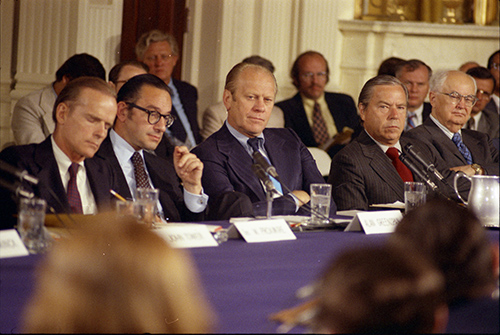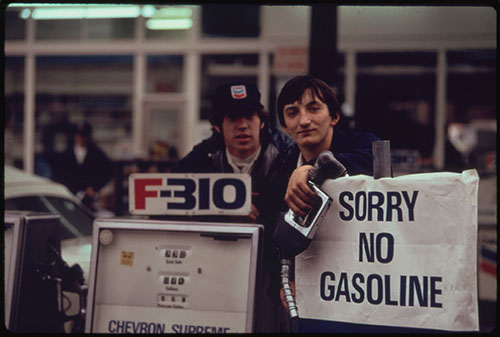Recent inflation in the United States has many people looking for parallels in other inflationary periods in American history, particularly the Great Inflation, a period from 1965-1980 during which the inflation rate twice reached double digits.[1] This post gives an overview of FRASER’s historical resources documenting the U.S. “Great Inflation” and the policy responses to the issue.

The Fed, the Executive Branch, and Congress
Beginning in the late 1960s, a relationship, and at times a dialogue, has existed between the Federal Reserve and other government entities—including Congress and the presidential administration—when it comes to inflation policy.[2] The following are various primary sources featuring this relationship, some of which are also included in the collection of materials economist Alan Meltzer used in his History of the Federal Reserve:
- Federal Open Market Committee meeting minutes from October 1965 paraphrase Chairman William McChesney Martin Jr. as resisting a policy change despite evidence of inflation, favoring “maintaining System relations within the Government” instead.
- In 1965, Martin gave a speech explaining the Fed’s role in the economy, notably suggesting that “it is monetary policy that must adapt itself to the hard facts of the [government] budget.”
- A series of memos from the FOMC in 1967 describes its “even-keel” policy and the Fed’s role in supporting Treasury debt financing.
- A collection of letters between the White House and Fed Chairman Arthur Burns in the early 1970s details the ongoing discussion of the connections between unemployment and inflation. One letter in particular, written by Nixon to Burns on November 4, 1971, showcases the President’s resolution to keep unemployment low to appease voters.
For further context to the archival materials, a 2006 paper by economist Burton Abrams details Nixon’s pressure on Burns, as evident in the Nixon Tapes.
Interpreting Inflation
Researchers often study the 1970s to understand the implications of various inflation policy choices and doctrines. The following resources help illustrate the ways in which inflation was viewed and discussed during the period.

Costs and Controls
Following the Economic Stabilization Act of 1970, which granted presidential authority for wage and price freezes, President Nixon addressed the nation on the 90-Day Freeze and the establishment of the Cost of Living Council. These initiatives, known as “incomes policies,” were aimed at curbing inflation through controlling certain prices (whether of oil, labor, or otherwise), an interpretation that saw inflation as “cost-push.” The following highlights the Fed’s response, with regard to the optimal combination of these incomes policies and monetary policy to stem inflation, observed in the Statements and Speeches of Arthur Burns:
- In October 1970, Burns spoke on the threat of collective-bargaining wage increases and other “violent” cost-push mechanisms, while pursuing a middle course “between monetary restraint and excessive monetary stimulus.”
- Prior to the dissolution of the Economic Stabilization Act in 1974, Burns made a statement before Congress concerning the efficacy of an incomes policy-guided approach.
Burns’ successor, G. William Miller, made similar considerations as to the necessary combination of monetary policy and price and wage controls, notably in a 1978 statement before the Joint Economic Committee.

Oil costs were of specific concern for these policymakers in crafting an inflation response. In addition to the incomes-policy approach Nixon employed, namely through oil price ceilings, the following other cost-reducing measures, which included adjusting domestic energy supply and consumption, were advocated by various administrators and Fed officials:
- Following a February 1974 FOMC meeting, Arthur Burns distributed documents to the FOMC on the Washington Energy Conference, which had taken place earlier that month. Among the documents was a statement by William E. Simon, administrator of both the Federal Energy Office and the Federal Energy Administration, concerning the energy crisis. Simon specifically mentions “Project Independence,” an initiative by oil-consuming countries to achieve energy independence.
- In a November 1974 statement before the Joint Economic Committee, Arthur Burns recommended “a policy of austerity” in response to a constrained oil supply, including developing alternative sources of domestic energy and reducing oil consumption through such measures as a gasoline tax. Burns references the Federal Energy Administration’s November report to Congress on Project Independence to support such recommendations.
- In 1978, San Francisco Fed President John Balles spoke on the joint issue of energy supply and inflation to the Anchorage Chamber of Commerce in Alaska.
- Testifying in 1979 as Secretary of the Treasury before the Joint Economic Committee, G. William Miller advocated reducing dependence on oil “to win the war on inflation.”
- From the Federal Reserve Bank of Atlanta’s 1980 Economic Review, “Hooked on Oil“: Economist William Cox discusses the improbability of American oil independence following the 1979 oil shock.
The Unemployment Tradeoff
In 1987, Arthur Burns gave a lecture in which he attributed prolonged inflation in the 1970s to a national pursuit of full employment that simultaneously tolerated inflation as a mere temporary consequence of growth. This tradeoff, promising high employment while sacrificing the price level, provides the basis for what is commonly called the Phillips curve. Such an employment-focused outlook characterized U.S. stabilization policy following the New Deal; however, given the persistent bouts of both unemployment and inflation in the 1970s, policymakers (like Burns) began challenging this notion of an “exploitable” long-run Phillips curve.[3] The following resources showcase how some Fed officials navigated this inflation-unemployment relationship:
- San Francisco Fed President John Balles addressed the California Bankers Association in 1973 on the relationship between expansive monetary policy, prices, and unemployment as previously understood in the Phillips curve.
- From the Federal Reserve Bank of Richmond’s July 1973 Economic Quarterly, “Changing Views of the Phillips Curve“: Richmond Fed researcher Thomas Humphrey identifies various parameters that render the traditional Phillips curve unstable.
- Fed Chair Arthur Burns gave a speech in 1975 on the unreliability of the Phillips curve tradeoff in the “current environment” of high prices.
- St. Louis Fed President Lawrence Roos gave a speech in 1977 denying a tradeoff between unemployment and inflation.
The Volcker Fed’s Anti-Inflation Approach
In 1979, Paul Volcker became Chairman of the Board of Governors after making the objective of controlling inflation clear in his confirmation hearings. Just months into his tenure, Volcker held an unscheduled FOMC meeting on October 6, 1979, and in a press conference on the Committee’s discussions that day, he explained plans to more effectively target monetary aggregates in pursuit of controlled money-supply growth. Though targeting monetary aggregates had been specified in the Federal Reserve Reform Act of 1977, Volcker explained in a technical paper submitted with his February 1980 testimony to Congress how new control mechanisms, such as focusing on bank reserves, would be more effective. Following the Fed’s new anti-inflation efforts, the inflation rate retreated from its peak of 14% in 1980 to below 4% by 1983.
For more resources on the 1970s and inflation, browse FRASER’s collection, which includes the Paul Volcker Papers, Statements and Speeches of Paul Volcker, FOMC meeting materials, and other inflation resources.
[1] U.S. Bureau of Labor Statistics. “Consumer Price Index for All Urban Consumers: All Items in U.S. City Average [CPIAUCSL].”
[2] Allan Meltzer. “Origins of the Great Inflation.” Federal Reserve Bank of St, Louis Review, March/April 2005.
[3] Robert Hetzel. “The Monetarist-Keynesian Debate and the Phillips Curve: Lessons from the Great Inflation.” Federal Reserve Bank of Richmond Economic Quarterly, Second Quarter 2013.
© 2022, Federal Reserve Bank of St. Louis. The views expressed are those of the author(s) and do not necessarily reflect official positions of the Federal Reserve Bank of St. Louis or the Federal Reserve System.


 @FedFRASER
@FedFRASER